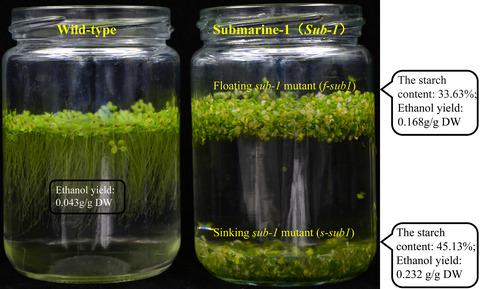当前位置:
X-MOL 学术
›
GCB Bioenergy
›
论文详情
Our official English website, www.x-mol.net, welcomes your
feedback! (Note: you will need to create a separate account there.)
A submerged duckweed mutant with abundant starch accumulation for bioethanol production
Global Change Biology Bioenergy ( IF 5.9 ) Pub Date : 2020-09-04 , DOI: 10.1111/gcbb.12746 Yu Liu 1, 2 , Hua Xu 3 , Yu Wang 3 , Xianfeng Tang 3 , Guo He 3 , Shumin Wang 3 , Yubin Ma 4 , Yingzhen Kong 5 , Changjiang Yu 3 , Gongke Zhou 1, 2
Global Change Biology Bioenergy ( IF 5.9 ) Pub Date : 2020-09-04 , DOI: 10.1111/gcbb.12746 Yu Liu 1, 2 , Hua Xu 3 , Yu Wang 3 , Xianfeng Tang 3 , Guo He 3 , Shumin Wang 3 , Yubin Ma 4 , Yingzhen Kong 5 , Changjiang Yu 3 , Gongke Zhou 1, 2
Affiliation

|
Duckweed is one kind of promising bioenergy plant with prominent advantages such as fast growth rate and high starch content. However, almost all previous studies focused on the natural duckweed germplasms. In this study, heavy‐ion irradiation was used to establish a mutant library of Lemna aequinoctialis 6002, and one mutant named submarine‐1 (sub‐1) was screened, which could accumulate more starch but with smaller granules. Unexpectedly, under proper external growth conditions such as poor nutritional status and insufficient growth space, sub‐1 mutant would sink underwater due to formation of dense tissue structure and large amount of fine starch particles with the extension of cultivation time. The starch content in the sinking sub‐1 increased to over 45% (dry weight) and was 12% higher than the floating sub‐1, highlighting that submergence can be considered as a spontaneous and efficient indicator for screening of high‐starch duckweed. Additionally, the saccharification efficiency of starch and ethanol yield had increased in sub‐1 mutant compared to the wild type. Based on the unique characteristics of sub‐1 mutant, a cultivation model of submerged duckweed in a simulated aquaculture pond was designed to get more starch‐rich biomass, enabling effective production of renewable bioenergy.
中文翻译:

具有丰富淀粉积累的沉水浮萍突变体,可用于生产生物乙醇
浮萍是一种有前途的生物能源植物,具有生长速度快,淀粉含量高等突出优点。但是,几乎所有以前的研究都集中在天然浮萍的种质上。在这项研究中,重离子辐射用于建立Lemna aequinoctialis 6002的突变体文库,并筛选了一个名为submarine-1(sub-1)的突变体,该突变体可以积累更多的淀粉,但颗粒更小。出乎意料的是,在适当的外部生长条件下(例如营养状况差和生长空间不足),sub-1突变体会由于形成致密的组织结构和大量细淀粉颗粒而随着培养时间的延长而沉入水下。下沉子1中的淀粉含量增加到超过45%(干重),比漂浮的sub-1高12%,这表明浸没可以被认为是筛选高淀粉浮萍的一种自发有效的指标。此外,与野生型相比,sub-1突变体中淀粉的糖化效率和乙醇产量都有所提高。根据sub-1突变体的独特特征,设计了在模拟水产养殖池中的浮萍养殖模型,以获取更多富含淀粉的生物质,从而有效地生产可再生生物能源。
更新日期:2020-09-04
中文翻译:

具有丰富淀粉积累的沉水浮萍突变体,可用于生产生物乙醇
浮萍是一种有前途的生物能源植物,具有生长速度快,淀粉含量高等突出优点。但是,几乎所有以前的研究都集中在天然浮萍的种质上。在这项研究中,重离子辐射用于建立Lemna aequinoctialis 6002的突变体文库,并筛选了一个名为submarine-1(sub-1)的突变体,该突变体可以积累更多的淀粉,但颗粒更小。出乎意料的是,在适当的外部生长条件下(例如营养状况差和生长空间不足),sub-1突变体会由于形成致密的组织结构和大量细淀粉颗粒而随着培养时间的延长而沉入水下。下沉子1中的淀粉含量增加到超过45%(干重),比漂浮的sub-1高12%,这表明浸没可以被认为是筛选高淀粉浮萍的一种自发有效的指标。此外,与野生型相比,sub-1突变体中淀粉的糖化效率和乙醇产量都有所提高。根据sub-1突变体的独特特征,设计了在模拟水产养殖池中的浮萍养殖模型,以获取更多富含淀粉的生物质,从而有效地生产可再生生物能源。











































 京公网安备 11010802027423号
京公网安备 11010802027423号